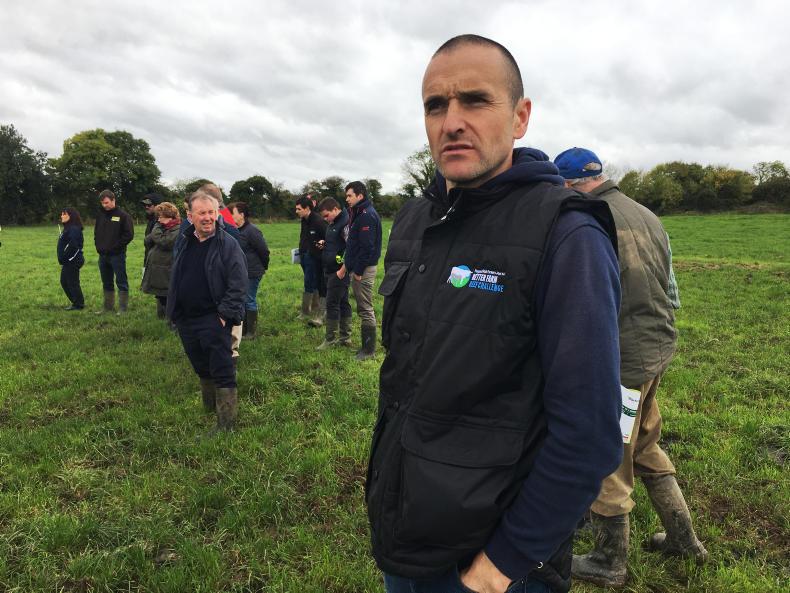Joe Healy farms alongside his father John on two blocks of land in North Co Meath. He is Meath’s representative in the new BETTER farm beef programme.
There are 44ha in total, with the majority around the home yard. This was a dairy grazing platform once upon a time, when John milked cows.
Host Joe Healy gives and update on grazing #Grass10 #BETTERfarm pic.twitter.com/7xslJ40CCK
— FJ Beef (@FJBeef) October 10, 2017
As a result, there is excellent grazing infrastructure in place – it easily the best laid out commercial beef farm that the Grass 10 programme has visited thus far.
Top performer
The farm is progressive, with Joe’s suckler herd achieving almost 1,000kg of live weight output per hectare in surpassing the €1,000 gross margin per hectare target set for the last phase of BETTER farm in 2016. The farm is stocked at 2.71 LU/ha, almost twice the national average and Joe will look to hit 3.1LU in 2021. He will do so by buying in beef stock to complement his own and increasing to 80 to 85 cows.
Joe opened his gates on Tuesday, inviting local farmers in to see how autumn closing was progressing.
One drinker in Joe Healy's 20 acre silage field serves 8 splits in a wheel-spoke grazing strategy #Grass10 pic.twitter.com/AkT4qt8MUS
— FJ Beef (@FJBeef) October 10, 2017
Grass 10 coordinator John Maher commended Joe on his strategy around autumn closing and indeed the grazing infrastructure of the farm itself, though Joe was quick to credit his father John for this.
“That work was already done for me,” Joe said.
“When you hear of infrastructure on farms you immediately think of sheds. But in this part of the world animals spend eight or nine months in the year outdoors – they need infrastructure out here too – Joe has this,” John Maher said.
Listen to John and Joe in our podcast below:
Closing up
Patrons were brought to the first paddock that Joe closed – 27% of the farm is closed to date. Already a regrowth was evident, though the principles of autumn closing mean that he will not come in again with stock until the spring time. It is one of the closest paddocks to the yard.
Joe has 25% of his ground closed to date. We're here in the first paddock he closed - close to the yard for easy access in spring #Grass10 pic.twitter.com/9WpuKvqN3q
— FJ Beef (@FJBeef) October 10, 2017
Joe is slightly ahead of schedule with his closing up. The guideline for a dry farm is to have 60% of grazing area grazed and closed up by the first week in November. However, given the mixed forecast for the coming week, John Maher advised attendees to be ahead, rather than behind, their targets.
“Things might get difficult in the coming weeks and we could miss out 60% figure in early-November. I’m not too concerned about what happens after that, but that 60% is crucial – it’ll form our staple diet next spring. We grow our spring grass in October,” Maher said, “Joe is slightly ahead of his target, but I wouldn’t slow down.”
Excellent infrastructure already in place here. Joe is running a stocking rate of 2.7LU/ha
— FJ Beef (@FJBeef) October 10, 2017
"It doesn't get better than this..." #Grass10 pic.twitter.com/kYD8bNCqqC
Lime
Joe’s local B&T advisor Donal McCabe, laid the law on lime on the day.
“There’s no point in spreading lots of expensive P and K fertiliser if the pH isn’t right,” he said, “if the lime is wrong it’s locked up.”
Donal revealed how some local soil tests were returning lime requirements of six tonnes per acre, such was the low pH status.
“In such a scenario, it’s a case of little and often. Going with too much lime at one time can lead to soil structure issues – ground can become tender. The ideal time to go with lime is after a tight grazing or silage cut.”
Donal advised how 2t of lime/acre would lift pH from 5.5 to 6 on a dry, sandy soil. Up to twice this amount could be needed for the same effect on heavy clay soils.
Get your complete guide to autumn closing in this week's paper






 This is a subscriber-only article
This is a subscriber-only article















SHARING OPTIONS: